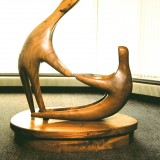HELPING HANDS SCULPTURE MULLINGAR GENERAL HOSPITAL
The sculpture depicts two life-sized figures,one helping the other off the ground. “The forms are not figurative and lack any facial
expressions. When you look across a busy street you recognize a person’s total physical form and movements. Thus I am relying on the total expression to communicate to the viewer the concept of this sculpture.”
Even though the figures are frozen in wood, it is the movement and rhythm they suggest that the viewer looks for and takes pleasure in
viewing. Art has that brief power, to free us out of our permanent egos and take us into the flux and movement of life.This is the great paradox within all of us; the one part demands permanence and the other longs for freedom to fly away.Artists have always known this; didn’t Freud say “wherever he went a poet had been there before him”
The first step involved drawing a sketch of the intended model, which was submitted to the Health Board for approval. They liked what
they saw and gave Michael the go-ahead with the sculpture. Both the Health Board and Michael pride themselves on the fact that it’s a
locally orientated project, with the timber used coming from forests in the Newtowncashel district.
The wood of the Wych Elm tree was chosen and Michael spent two weeks working on a model one-sixth the size of the end product,
and began construction with this as a guide.
Unforeseen problems included the timber having a moisture content of 60% – for timber not to crack, its moisture content has to be no more than 10%, and the resulting process of doing that is both slow and tedious. Michael initially brought samples of wood to three commercial kilns, which proved unsuccessful. He was left with only one option – to build his own kiln.
Using the measurement specifications of an English designer, it took Michael three weeks to build his kiln. It’s totally insulated, with walls five inches thick and with a set temperature control. The moisture leaves the timber by means of a fan guiding it into a pipe. The wood was in the kiln for 8 months – at the start of the drying process 2 gallons of water per day left the wood.
Michael Casey starts work at 9 am every morning and says he has to try to live “a very disciplined life” when he is working on a
sculpture. Summer time is his favourite time of year because he can work outdoors “until about 11 pm, and then fall into bed totally exhausted but very happy.” His favourite part of the day is evening time, and he says that he dislikes interruptions when he is working. A lover of classical music, he likes to listen to the radio when he is working, and says it is difficult to explain “the sheer joy of chiselling away at a sculpture with music in the background on a lovely summer’s evening.”
The rough figure cut out of the wood after being demoisturised, there followed months of back-breaking work of chiselling, drilling,
and sanding down, to attain the required shape and smoothness.
“In working on a sculpture like this it was necessary to impose a concept and forms onto the wood. The most dominant form in this sculpture is the oval. This was Elly’s idea – it runs throughout the sculpture from the base to the head. The oval is a far more interesting shape than the circle.” The finished product will adorn the entrance to Mullingar Hospital, serving as a reminder to all of the dedication
of those in the nursing profession, while at the same time being aesthetically pleasing to the human eye.
Michael’s Bog Wood Gift Products
Contact Details
- Casey's Sculptures, Barley Harbour, Newtowncashel, Co Longford, Ireland.
- +353 (0)43 332 5297
- TO AVOID DISSAPOINTMENT PLEASE RING STUDIO BEFORE VISITING.
- info@bogwood.net


